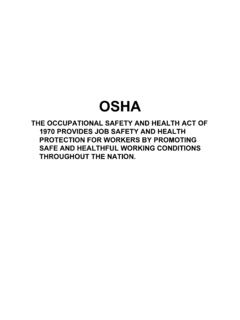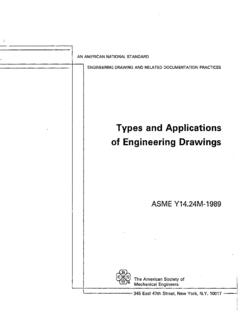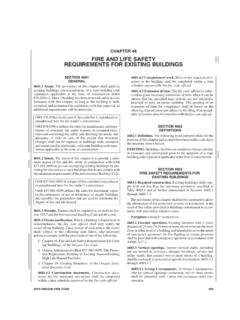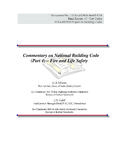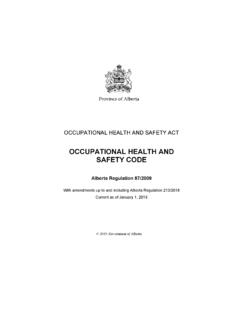Transcription of Understanding the Life Safety Code
1 Loss Control DepartmentTechnical Information Paper SeriesUnderstanding theLife Safety CodeCopyright 1997 The Hartford Loss Control DepartmentTIPS Series S Printed in document is provided for information purposes only. It is not intended to be a substitute for individual legalcounsel or advice on issues discussed within. Readers seeking resolution of specific legal issues or businessconcerns related to the captioned topic should consult their attorney and/or insurance the life Safety code 1997 The Hartford Loss Control Department TIPS S Page 1 Understanding the life Safety CodeOrigin and Development of The life Safety code (NFPA 101)The life Safety code exists today primarily because a number of devastating, catastrophicfires focused national attention on the fire problem and the inadequacies of life safetyfeatures in buildings.
2 In each of the fires listed below, a lack of consideration for lifesafety features in building construction, especially exit facilities, was a major factor in themagnitude of fire deaths. Coconut Grove Night Club Fire, Boston, MA, November 19, 1942: 492 dead La Salle Hotel Fire, Chicago, IL, June 5, 1946: 61 dead Winecoff Hotel Fire, Atlanta, GA, December 7, 1946: 119 dead Canfield Hotel Fire, Dubuque, IA, June 9, 1946: 19 deadAlthough improvements in life Safety that resulted from these and other devastating firesformed the basis of the code , the code also addresses life Safety for similar emergencies( , bomb threats).The life Safety code is published as NFPA 101. The tables and other information in thisarticle were taken from the 1994 edition of the life Safety of the life Safety CodeTo apply the code , it is important to understand its layout and content.
3 The code iscomprised of six major parts, as outlined in Table 1, reading the code , pay careful attention to the numbering system used for the individualsections. The first digit indicates the chapter; the second digit indicates the sectionnumber; the third digit indicates the subsection, etc. Note that some of the sectionnumbers include an asterisk at the end of the number. This asterisk indicates thatadditional information is available in Appendix A. Finally, a thin black vertical line in themargin identifies changes from the previous edition. NFPA publishes a new edition of theLife Safety code every three Authority. It is important to understand that the code has no legal authority, unlessit has been adopted as law within the jurisdiction of the governing body whereconstruction is to take place.
4 A majority of states have adopted the code as law;however, the effectiveness of any law depends upon aggressive , inconsistent or lax enforcement of the code is at times the weak-link of theentire the life Safety code 1997 The Hartford Loss Control Department TIPS S Page 2 Table 1. code Organization and through 7 Core or Fundamental Information28 through 29 Occupancy330 Special Structures and High Rise Buildings431 Operating Features532 Mandatory Referenced Publications6 Appendices A and BUseful additional information**Note that the appendixes are not part of the requirements of the code , but are includedfor information purposes of the life Safety CodeAdministration and Fundamental Requirements. Chapters 1 and 2 of the life SafetyCode specify the intended goals of meeting the code s requirements.
5 1) To provide for adequate Safety without dependence on any single safeguard2) To ensure that construction is sufficient to provide structural integrity during a firewhile occupants seek safe refuge within the building or egress to the building exterior3) To provide an appropriate degree of life Safety considering the size, shape, and natureof the occupancy4) To ensure that the egress paths are clear, unobstructed, and unlocked5) To ensure that the exits and egress routes are clearly marked to provide the necessarycues and avoid confusion6) To provide adequate lighting7) To ensure prompt occupant response by providing warning of fire8) To provide for back-up or redundant egress arrangements9) To ensure suitable enclosure of vertical openings10) To allow for design criteria that exceed the scope of the Chapter 3 provides definitions of terms commonly used in the code .
6 Forexample, the term shall indicates a mandatory requirement, while the term shouldindicates a recommended of Occupancy and Hazard of Contents. Chapter 4 introduces some basicterminology in the classification of occupancies and contents hazards. An ability toproperly classify occupancies and hazards is essential to correct application of the of Egress. Chapter 5 establishes minimum requirements for the means of egressfor application to all occupancy classifications. It specifically covers the components,number, size, arrangement, lighting, and identification of means of the life Safety code 1997 The Hartford Loss Control Department TIPS S Page 3 Features of Fire Protection. Chapter 6 establishes basic requirements for features of fireprotection, which include construction, compartmentation through use of fire barriers,protection of vertical openings, subdivision of building space through use of smokebarriers, protection from hazards, and interior finish.
7 This chapter specifies a menu ofprotection options, which are mandated to varying degrees by specific occupancychapters. However, some provisions of this chapter apply as requirements to Service and Fire Protection Equipment. Chapter 7 provides cross-references toother codes and standards that provide design guidance for building service provisions of these various codes and standards must be followed to comply with theCode. Referencing these codes and standards within the body of the code reinforces thefact that compliance with these codes is mandatory. Sections 7-6 and 7-7, which providemenus of the various options for detection, alarm, and communications systems orautomatic extinguishing systems, are mandated only where referenced by another sectionof the Chapters. All of the chapters dealing with the individual occupancy types(Chapters 8 through 29) follow the same general pattern.
8 That is, they address the topicsof occupant load, types of exits, capacity of exits, number of exits, etc. Many of thespecifications for different occupancies are the same, but many variations also study of previous chapters will have made you aware of the areas where thevariations and similarities in specifications are most likely to exist, thus allowing acomprehensive study of several chapters at Structures and High Rise Buildings. The requirements of Chapter 30 apply tooccupancies regulated by Chapters 8-29 that are in special structures or high-risebuildings. This section of the code deals with types of buildings rather than types ofoccupancies. The requirements of this chapter are special because the structures underconsideration are unique (for example, man-made caves that have been converted intostorage buildings, mercantile, or offices).
9 Requirements for high-rise buildings are alsocovered in this Features. The provisions in Chapter 31 complement the features mandated bythe earlier chapters of the code . These complete the package of requirements that ensurea minimum, acceptable level of Safety to life . As a rule, codes and standards are confinedto the subject of proper building arrangements, without emphasis or advice on issues suchas maintenance, inspection, drills, or the regulation of building contents. This chapterfocuses on how individuals ( , occupants, owners, maintenance personnel, etc.) canaugment the fixed, active life Safety systems and other passive building features requiredby the Through the code . Table 2 (below) presents a suggested procedure fordetermining the code requirements for a building or the life Safety code 1997 The Hartford Loss Control Department TIPS S Page 4 Table 2.
10 Navigating Through the CodeSTEPREFERENCES1. Determine the occupancy to the occupancy definitions in Chapter4 and the occupancy Chapters 8 through Determine if the building or structure isnew or to the definitions in Chapter Determine the occupant to and the section ofoccupancy Chapters 8 through Determine the hazard of to Section Refer to the applicable occupancy chapterof the 8 through 29. Also refer asnecessary to Chapters 1 through 7 for generalinformation, or as directed by the Determine the occupancy subclassificationor special use condition, if following new and existing occupancychapters contain subclassifications or specialuse definitions: Assembly, Health Care,Detention and Correctional, Hotels andDormitories, Residential Board and Care, andMercantile Proceed through the applicable occupancychapter verifying compliance with eachreferenced section, subsection, paragraph,subparagraph, and referenced codes,standards, and other Where two or more requirements apply,the occupancy chapter generally takesprecedence over the base Chapters 1through Where two or more occupancy chaptersapply, such as in a mixed use building, themost stringent requirements Operating feature requirementsRefer to Chapter 31 ConclusionThe purpose of the life Safety code is to establish minimum requirements that willprovide a reasonable degree of Safety from fire and similar emergencies in buildings andstructures.
